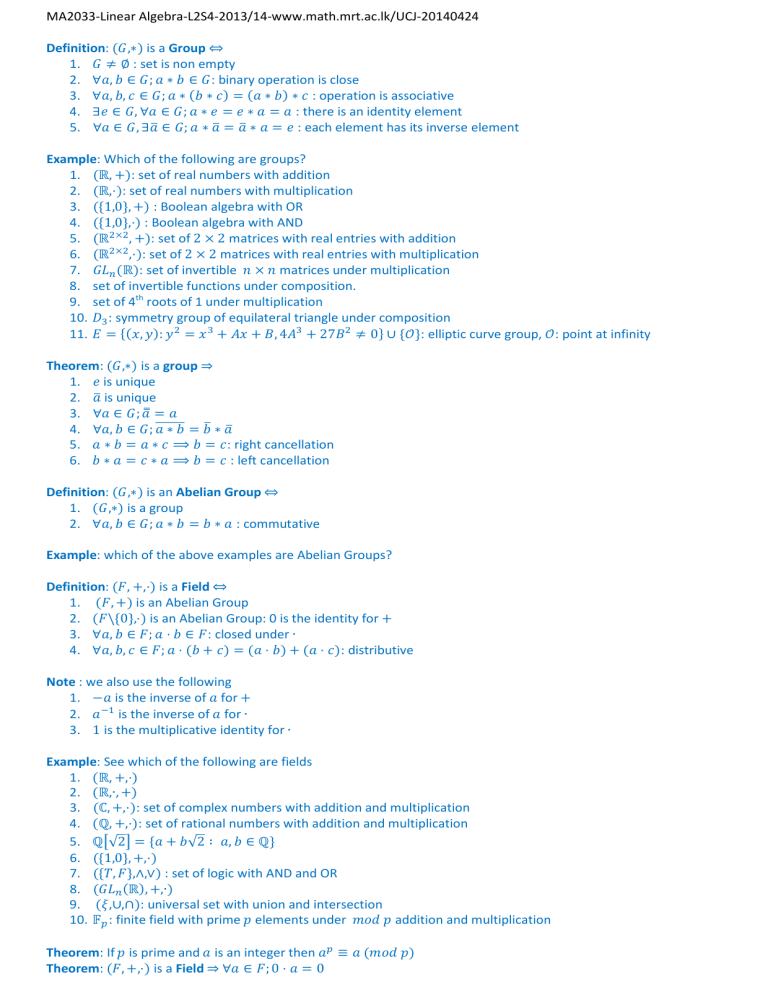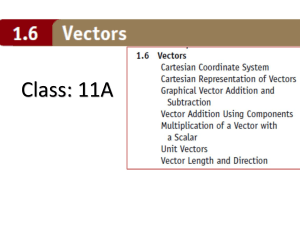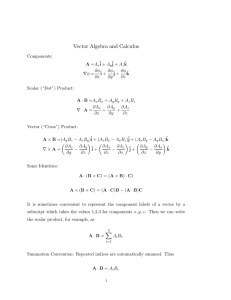
MA2033-Linear Algebra-L2S4-2013/14-www.math.mrt.ac.lk/UCJ-20140424
Definition: (,∗) is a Group ⇔
1. ≠ ∅ : set is non empty
2. ∀ , ∈ ; ∗ ∈ : binary operation is close
3. ∀ , , ∈ ; ∗ ( ∗ ) = ( ∗ ) ∗ : operation is associative
4. ∃ ∈ , ∀ ∈ ; ∗ = ∗ = : there is an identity element
5. ∀ ∈ , ∃ ∈ ; ∗ = ∗ = : each element has its inverse element
Example: Which of the following are groups?
1. (ℝ, +): set of real numbers with addition
2. (ℝ,⋅): set of real numbers with multiplication
3. ({1,0}, +) : Boolean algebra with OR
4. ({1,0},⋅) : Boolean algebra with AND
5. (ℝ× , +): set of 2 × 2 matrices with real entries with addition
6. (ℝ× ,⋅): set of 2 × 2 matrices with real entries with multiplication
7. (ℝ): set of invertible × matrices under multiplication
8. set of invertible functions under composition.
9. set of 4th roots of 1 under multiplication
10. !: symmetry group of equilateral triangle under composition
11. " = {(#, $): $ = # ! + &# + ', 4&! + 27' ≠ 0} ∪ {+}: elliptic curve group, +: point at infinity
Theorem: (,∗) is a group ⇒
1. is unique
2. is unique
3. ∀ ∈ ; . =
4. ∀ , ∈ ; ∗ = ∗
5.
∗ = ∗ ⟹ = : right cancellation
6.
∗ = ∗ ⟹ = : left cancellation
Definition: (,∗) is an Abelian Group ⇔
1. (,∗) is a group
2. ∀ , ∈ ; ∗ = ∗ : commutative
Example: which of the above examples are Abelian Groups?
Definition: (0, +,⋅) is a Field ⇔
1. (0, +) is an Abelian Group
2. (0\{0},⋅) is an Abelian Group: 0 is the identity for +
3. ∀ , ∈ 0; ⋅ ∈ 0: closed under ∙
4. ∀ , , ∈ 0; ⋅ ( + ) = ( ⋅ ) + ( ⋅ ): distributive
Note : we also use the following
1. − is the inverse of for +
2. 45 is the inverse of for ∙
3. 1 is the multiplicative identity for ∙
Example: See which of the following are fields
1. (ℝ, +,⋅)
2. (ℝ,∙, +)
3. (ℂ, +,⋅): set of complex numbers with addition and multiplication
4. (ℚ, +,⋅): set of rational numbers with addition and multiplication
5. ℚ8√2: = { + √2 ∶ , ∈ ℚ}
6. ({1,0}, +,⋅)
7. ({<, 0},∧,∨) : set of logic with AND and OR
8. ( (ℝ), +,∙)
9. (?,∪,∩): universal set with union and intersection
10. AB : finite field with prime C elements under DEF C addition and multiplication
Theorem: If C is prime and is an integer then B ≡
Theorem: (0, +,⋅) is a Field ⇒ ∀ ∈ 0; 0 ⋅ = 0
(DEF C)
MA2033-Linear Algebra-L2S4-2013/14-www.math.mrt.ac.lk/UCJ-20140424
Definition: (H,∗,∘) is a vector space over (0, +,⋅)
1. (H,∗) is an Abelian Group
2. (0, +,⋅) is a Field
3. ∀ ∈ 0, ∀# ∈ H; ∘ # ∈ H: closed under scalar multiplication
4. ∀ , ∈ 0, ∀# ∈ H; ( + ) ∘ # = ( ∘ #) ∗ ( ∘ #) : distributive w.r.t. scalar addition
5. ∀ ∈ 0, ∀#, $ ∈ H; ∘ (# ∗ $) = ( ∘ #) ∗ ( ∘ $) : distributive w.r.t. vector addition
6. ∀ , ∈ 0, ∀# ∈ H; ( ⋅ ) ∘ # = ∘ ( ∘ #) : associative w.r.t. scalar product
7. ∀# ∈ H; 1 ∘ # = #
Note: the above four operations are functions such that
+: 0 × 0 → 0: scalar addition
⋅: 0 × 0 → 0: scalar product
∗: H × H → H: vector addtiopn
∘: 0 × H → H: scalar multiplication
Example: which of the above examples are Vector Spaces?
1. (ℝ , +,⋅) over (ℝ, +,⋅): set of vectors with real entries
2. (ℝ, +,⋅) over (ℝ, +,⋅)
3. (ℂ, +,⋅) over (ℝ, +,⋅)
4. (ℝ, +,⋅) over (ℂ, +,⋅)
5. (ℂ, +,⋅) over (ℂ, +,⋅)
6. (ℝ[#], +,⋅) over (ℝ, +,⋅): set of polynomial in # with real coefficients
7. (H, +,⋅) over (ℝ, +,⋅): set of solution of a linear differential equation
8. (M[0,1], +,⋅) over (ℝ, +,⋅): continuous functions on [0,1]
Theorem:
(H,∗,∘) over (0, +,⋅) is a vector space ⇒
1. ∀# ∈ H; 0 ∘ # = 2. ∀ ∈ 0; ∘ = 3. ∀ ∈ H, ∀ ∈ 0; (− ) ∘ # = (
∘ #)
4.
∘ # = ⇒ = 0 EN # = Definition:
(O,∗,∘) is a sub vector space of (H,∗,∘) over (0, +,⋅) ⟺
1. (H,∗,∘) is a vector space over (0, +,⋅)
2. O ⊆ H
3. (O,∗,∘) is a vector space over (0, +,⋅)
Theorem:
1. (H,∗,∘) is a vector space over (0, +,⋅)
2. O ⊆ H: subset
3. ∀#, $ ∈ H; # ∗ $ ∈ H: closed under addition
4. ∀ ∈ 0, ∀#, $ ∈ H; ∘ # ∈ H: closed under scalar multiplication
⇒
1. (O,∗,∘) is a vector space over (0, +,⋅)
2. (O,∗,∘) is a sub vector space of (H,∗,∘) over (0, +,⋅)
Note: When there is no threat of confusion we may use the following
1. # ∗ $ = # + $
2.
⋅ =
3.
∘# = #
4. #̅ = −#
5. = 0
Example: Write the rules for vector space with this new notation
H is a vector space over 0 (or H is a 0-vector space)
' ⊆ H, ST ∈ ', T ∈ 0
Definition: ∑T
T ST
is a linear combination of '
MA2033-Linear Algebra-L2S4-2013/14-www.math.mrt.ac.lk/UCJ-20140424
Definition: VC ' = { ∑T
T ST
:
T
∈ 0, ST ∈ '}: set of all possible linear combinations of the elements of '.
Theorem:
1. VC ' is a subspace of H
2. VC ' is the smallest subspace of H containing '
Definition: ' is linearly independent ⟺
∀ = ( 5 , ⋯ , ) ∈ 0 ; X Y = ∑T T ST = 0 ⇒
=0
Definition: ' is linearly dependent ⟺ ' is not linearly independent
Theorem:
1. |'| ≥ 2
2. ' is linearly dependent
⇒ At least one element of ' can be written as a linear combination of the other elements
Definition: ' ⊆ H is a basis for H ⟺
1. span ' = H
2. ' is linearly independent
Example: Find a basis for the following vector spaces
1. ℝ
2. set of solution of a linear differential equation
3. b (ℝ): set of polynomials with degree or less
4. ℝ[#] = c(ℝ) : set polynomials with real coefficients
5. set of Taylor series expandable functions on [0,1]
6. set of Fourier series expandable functions on [0,1]
7. M[0,1] : continuous functions on [0,1]
Definition:
1. ' is a basis for H
2. |'| is finite
⟺ H is finite dimensional
Note: From here on we will work with finite dimensional vector spaces
Theorem:
1. H is finite dimensional
2. ' is a basis for H
⇒ each vector in H can be uniquely expressed as a linear combination of the vectors in '
Theorem:
1. H is finite dimensional
2. ' is a basis for H
⇒ every set with more than |'| vectors is linearly dependent
Theorem: H is finite dimensional ⇒ any two bases for H have the same size
Definition: Dimension
1. H is finite dimensional
2. ' is a basis for H
⟺ FdD H = |'|
Definition: FdDe0f = 0
Definition: standard basis for ℝ
' = {T }
T = Xg5×(T45) , 1, g5×(4T) Y
MA2033-Linear Algebra-L2S4-2013/14-www.math.mrt.ac.lk/UCJ-20140424
H is a vector space over 0
0 = ℂ , S, h, i ⊆ H, ∈ 0
Definition: inner product
1. ⟨∙,∙⟩: H × H → 0 = ℂ is a function
2. ⟨S, h⟩ = ⟨h, S⟩
3. ⟨S + h, i⟩ = ⟨S, h⟩ + ⟨h, i⟩
4. ⟨ S, h⟩ = ⟨S, h⟩
5. ⟨S, S⟩ ≥ 0 and ⟨S, S⟩ = 0 ⟺ S = 0
⟺ ⟨∙,∙⟩ is an inner product
Note: we have
=
when 0 = ℝ
Definition: H is an inner product vector space ⟺ H has an inner product defined
Theorem:
1. ⟨S, h + i⟩ = ⟨S, h⟩ + ⟨S, i⟩
2. ⟨S, h⟩ = ⟨S, h⟩
3. ⟨0, S⟩ = ⟨S, 0⟩ = 0
Example: Show that the following are inner products
1. S, h ∈ ℝ , 0 = ℝ; ⟨S, h⟩ = S ∙ h
2. S, h ∈ ℂ , 0 = ℝ; ⟨S, h⟩ = S ∙ h̅
o
3. l, m ∈ M([ , ]), 0 = ℝ; ⟨l, m⟩ = np l(#)m(#)F#
Definition: Norm induced by the inner product ‖S‖ = r⟨S, S⟩
Theorem:
1. ‖S + h‖ ≤ ‖S‖ + ‖h‖ : triangular inequality
2. |⟨S, h⟩| ≤ ‖S‖‖h‖ : Cauchy-Schwarz inequality
Definition: S and h are orthogonal ⟺ ⟨S, h⟩ = 0
Definition: S and h are orthonormal ⟺
1. S and h are orthogonal
2. ‖S‖ = ‖h‖ = 1
Definition: ' is orthogonal ⟺ ∀d ≠ t; ST and Su are orthogonal
Definition: ' is orthonormal⟺ ∀d ≠ t; ST and Su are orthonormal
Theorem: ⟨∑Tv5
T
ST , h ⟩ = ∑Tv5
Theorem:
1. ' is orthogonal
2. 0 ∉ '
⟹ ' is linearly independent
T
⟨ST , h⟩
Theorem: If {ST } is an orthonormal basis for a vector space H then any h ∈ H can be written as
h = ∑Tv5⟨ST , h⟩ST
Definition: Orthogonal complement of a subspace x in an inner product space H
x y = {S ∈ H: < S, i >= 0 ∀i ∈ x}
Theorem: x y is a subspace of H
Theorem: Let H be an inner product space and x be a subspace spanned by the orthonormal set {i5 , i , ⋯ , i }.
Then we can write S = cS + |S ∈ H where cS = ∑Tv5 < S, iT > iT ∈ x and |S ∈ x y






